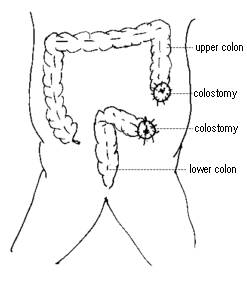What Is A Colostomy ?
In simple terms, a colostomy is when the colon is cut in half and the end leading to the stomach is brought through the wall of the abdomen and attached to the skin. The end of the colon that leads to the rectum is closed off and becomes dormant. This is known as a “Hartmann’s Colostomy”.
There are other types of colostomy procedures, but this one is the most common.

Usually a colostomy is performed for infection, blockage, or in rare instances, severe trauma of the colon. This is not an operation to be taken lightly. It is truly quite serious and demands the close attention of both patient and doctor. A colostomy is often performed so that an infection can be stopped and/or the affected colon tissues can heal. The alternative to the colostomy is often pretty grim, death. Just be glad you are here. It is important realize that, with a few exceptions, you can look forward to having the colostomy reversed.
How is a colostomy created?
- an abdominal opening is created
- the intestines are brought out through the skin
- the intestine is sutured to the skin
- the stoma is complete
Types of Colostomies in India
There are several different types of colostomies including ascending, transverse, and descending :
- Ascending. This colostomy has an opening created from the ascending colon, and is found on the right abdomen. Because the stoma is created from the first section of the colon, stool is more liquid and contains digestive enzymes that irritate the skin. This type of colostomy surgery is the least common.
- Transverse. This surgery may have one or two openings in the upper abdomen, middle, or right side that are created from the transverse colon. If there are two openings in the stoma, (called a double–barrel colostomy) one is used to pass stool and the other, mucus. The stool has passed through the ascending colon, so it tends to be liquid to semi-formed.
- Descending or sigmoid. In this surgery, the descending or sigmoid colon is used to create a stoma, typically on the left lower abdomen. This is the most common type of colostomy surgery and generally produces stool that is semi-formed to well-formed because it has passed through the ascending and transverse colon.
What does a Colostomy do?
After a colostomy has been created, the intestines will work just like they did before except:
- The colon and rectum beyond the colostomy is disconnected or removed.
- The anus is no longer the exit for stool.
Since nutrients are absorbed in the small intestine, a colostomy does not change how the body uses food. The main functions of the colon are to absorb water, to move the stool toward the anus, and to store it in the rectum until it is passed out of the body. When a colostomy changes the stool’s route, the storage area is no longer available.
The higher up in the colon the colostomy is made, the shorter the bowel is. The less time the bowel has to absorb water, the softer or more liquid the stool is likely to be. A colostomy further down in the colon, near the rectum, will discharge stool that has been in the intestine a longer time. Depending on the effects of illness, medicines, or other forms of treatment, the longer bowel can put out a more solid or formed stool. Some people with colostomies find that they are able to pass this stool at certain times of the day with or without the help of irrigation. (Irrigation is discussed later in this document)
After surgery, some people still may feel urges and even have some discharge from the anal area. This discharge is mucus, blood, and at times stool, left from the operation. If the rectum is left alone during surgery, it will keep putting out mucus that can be harmlessly passed whenever you have the urge.
Risks
- Bleeding inside your belly
- Damage to nearby organs
- Development of a hernia at the incision site
- Infection, particularly in the lungs, urinary tract, or belly
- Narrowing or obstruction of the colostomy opening (stoma)
- Scar tissue forming in your belly and causing intestinal blockage
- Skin irritation
- Wound breaking open
After The Procedure in India
You will be in the hospital from 3 to 7 days. You may have to stay longer if your colostomy was an emergency operation.
You may be able to suck on ice chips on the same day as your surgery to ease your thirst. By the next day, you will probably be allowed to drink clear liquids. Your health care providers will slowly add thicker fluids and then soft foods as your bowels begin to work again. You may be eating normally within 2 days after your surgery.
The colostomy drains stool (feces) from the colon into the colostomy bag. Most colostomy stool is softer and more liquid than stool that is passed normally. How liquid the stool is depends on the location of the segment of intestine used to form the colostomy.














